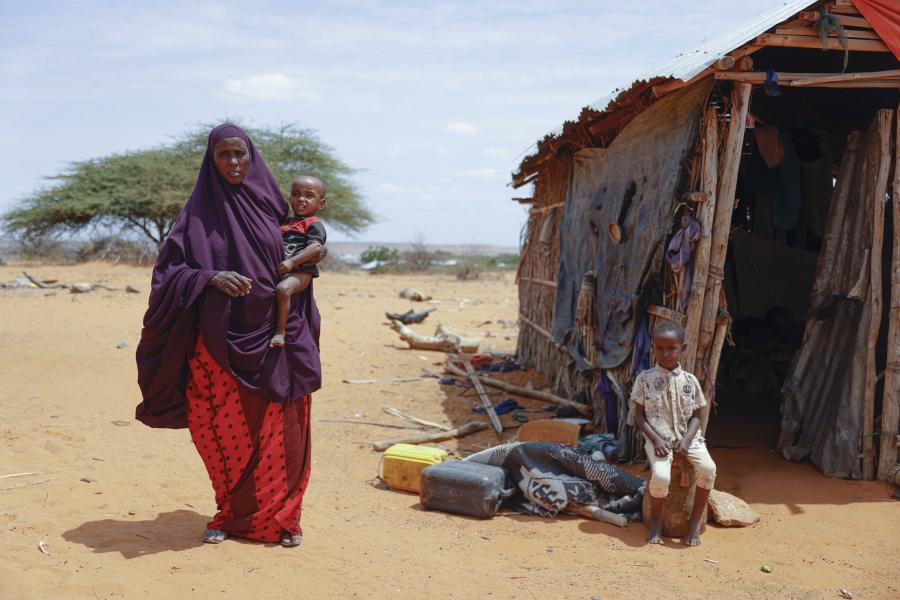2022 Year-end population figures
-
Refugees: 71,000 Ethiopian refugees and asylum-seekers in Sudan; 163,100 Eritrean refugees and asylum-seekers in Ethiopia
-
IDPs: 2.7 million
-
IDP returnees: 1.9 million (49,800 assisted by UNHCR)
2022 Situation Overview
The two-year conflict in northern Ethiopia affected the lives and livelihoods of millions of Ethiopians and displaced many people, including refugees who had arrived from Eritrea in previous years and were hosted in refugee camps in northern Ethiopia.
Although a humanitarian truce was declared in March 2022, hostilities resumed in August 2022, aggravating the already dire humanitarian and security situation. Intense clashes triggered further displacements, as well as creating humanitarian access challenges in northern Ethiopia and leaving basic services extremely stretched. Efforts to bring humanitarian aid into Ethiopia's northern Tigray region were suspended following the renewed outbreak of fighting and the blocking of access roads. The cancellation of UNHAS flights to the regional capital Mekelle resulted in a complete lack of cash flow to the operation, affecting UNHCR’s response. Due to the volatile security situation throughout Tigray, including an increase in airstrikes, and following an announcement from the Ethiopian government that aid organizations should refrain from working in areas where the Government was taking "preventive measures", UNHCR field missions were suspended for some days in September.
In September 2022, UNHCR declared an internal Level 1 emergency for Sudan due to the deteriorating situation in Ethiopia, enhancing preparedness and response capacity for a potential influx of refugees into Sudan's Gedaref and Kassala states.
In November 2022, the Government of Ethiopia and the Tigray People’s Liberation Front signed a cessation of hostilities agreement. The delivery of humanitarian services as well as access to cash, fuel and communication services partially resumed, and some internally displaced people in Tigray and neighbouring Afar and Amhara regions returned to their homes.
By the end of 2022, an estimated 2.7 million people were internally displaced and 71,000 Ethiopian refugees and asylum-seekers (the majority of whom arrived in 2020) were registered in Sudan. The emergency response in Sudan focused on providing life-saving assistance and protection in the new refugee camps in Gedaref and Blue Nile states, while ensuring preparedness in the event of a new influx.
In November 2022, UNHCR and the Ethiopian Government's Refugee and Returnee Service (RRS) assisted the first accompanied relocation of refugees to Amhara from the Mai Tsebri camps in Tigray (Adi Harush and Mai Aini) since the start of the conflict two years previously. By the end of the exercise, UNHCR was able to relocate 7,000 individuals. By the end of 2022, the Alemwach site in the Amhara region hosted 22,300 refugees. Shelter, core relief items and food were provided for all refugees. Medical and nutrition screening of relocated refugees continued through UNHCR’s partners. The newly relocated refugees also received mental health and psychosocial support (MHPSS) as well as medical referrals.
During 2022, 2.36 million IDPs benefited from UNHCR's protection and solution interventions in northern Ethiopia. IDPs had access to 70 protection desks for counselling, referrals and case management in the three regions. Close to 90,000 IDPs and IDP returnees received counselling services. A total of 119,000 IDPs were reached with awareness-raising sessions on the prevention, mitigation and response to gender-based violence. The protection desks provided IDPs with information on protection issues, including relocation to established IDP sites, and provided access to psychosocial counselling and referrals to other service providers for specific assistance. Protection desks are also used by operational partners for certain activities in coordination with UNHCR.
The signing of the peace agreement encouraged some IDPs to return home. In 2022, close to 500,000 IDPs returned to their places of origin in northern Ethiopia. This encompassed nearly 50,000 assisted by UNHCR to return home, including 34,000 to Tigray. A total of 40,000 people were assisted with cash, including cash for shelter reconstruction and repair, multi-purpose cash, and cash for transport.
In Sudan, UNHCR and partners continued to ensure the protection response, with particular attention to gender-based violence and sexual exploitation and abuse, and to maintain the civilian and humanitarian character of asylum within the camps. Some of the key areas of work included strengthening referral pathways, raising awareness and supporting community-based networks, including additional protection desks and child friendly spaces and psychosocial support. Inter-agency training was provided to Government officials, humanitarian actors and refugee volunteers.
No major return movements from Sudan were observed in 2022. UNHCR closely monitored the situation and worked with relevant stakeholders to help refugees obtain accurate and verified information about the situation in Tigray to enable them to make informed decisions about returns. Any repatriation of refugees to their places of origin must be strictly voluntary and based on a well-informed and individual decision.
